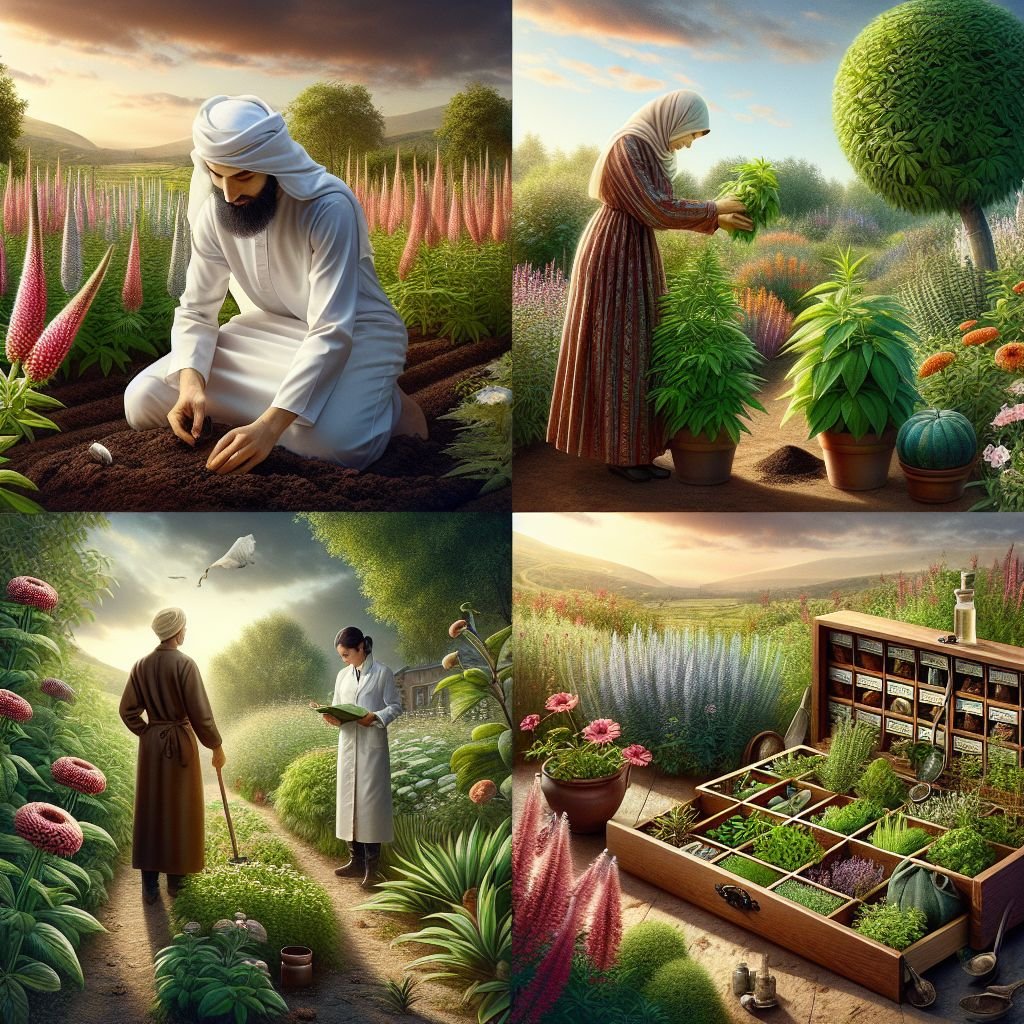Key Takeaways
-
Designing a medicinal garden offers both health benefits and a sense of empowerment through growing your own remedies.
-
Selecting the right location and understanding the needs of your plants are crucial for a thriving medicinal garden.
-
Companion planting can enhance the growth and potency of your medicinal herbs.
-
Starting with easy-to-grow medicinal plants can help beginners gain confidence and experience.
-
Regular care, including proper soil management and natural pest control, ensures the longevity and success of your garden.
The Healing Power of Medicinal Plants
Imagine stepping into your backyard and being greeted by a lush array of greenery, each plant with its own special healing properties. This isn’t just a garden; it’s a sanctuary where nature’s medicine blooms right at your fingertips. I’m here to guide you through transforming your yard into a medicinal oasis, a place where wellness isn’t just a concept, it’s a living, breathing part of your home.
Common Ailments and the Herbs That Help
Before we dive into garden designs and plant selection, let’s talk about why you’d want to grow medicinal herbs in the first place. Herbs like peppermint can soothe an upset stomach, while chamomile is renowned for its calming effects. Imagine the convenience of having these remedies growing just steps away from your kitchen door. It’s practical, cost-effective, and immensely satisfying.
Essential Perennial Herbs for Year-Round Remedies
Perennial herbs are the backbone of a medicinal garden. These are the plants that, once established, will provide healing remedies year after year. Echinacea, for example, boosts the immune system and is a staple in any wellness garden. Lavender, with its soothing scent, is perfect for crafting homemade essential oils or simply for its stress-relieving properties when you stroll through your garden.
Designing Your Medicinal Garden Layout
Designing a medicinal garden is more than just planting seeds and hoping for the best. It’s about creating a space that is not only beautiful but functional. You want to consider the sunlight, the soil, and how water drains through your yard. Most importantly, you want to create a space that feels good to you because this is where you’ll nurture not just your plants, but your own well-being.
Choosing the Right Location
The right location is paramount. Most medicinal herbs thrive in full sun, so find a spot that gets at least six hours of direct sunlight daily. However, don’t despair if your yard is more shadow than light—many herbs also do well in partial shade. The key is to match the plant to the place, and I’ll show you exactly how to do that.
Creating Zones for Different Healing Herbs
Creating zones within your garden can help organize your plants based on their needs and uses. For instance, you might have a zone for culinary herbs close to the kitchen and another for relaxation herbs near a seating area. This not only makes for a more efficient garden but also enhances your experience as you move through different spaces with different intentions.
Companion Planting for a Thriving Medicinal Ecosystem
Companion planting is a time-honored tradition that goes beyond just aesthetics. It’s about understanding which plants help each other grow better. For example, planting basil near your tomatoes can help repel pests, while marigolds can deter nematodes and other garden pests. These relationships create a thriving ecosystem that supports the health of your medicinal plants.
Once you’ve established the perfect location and layout for your medicinal garden, the next exciting step is selecting the plants that will inhabit this space. Choosing the right plants is like picking out the colors for a painting—you want a variety of hues, textures, and, in this case, healing properties. Let’s talk about which plants are ideal for starting your healing sanctuary.
Plant Selection for Your Healing Sanctuary
When selecting plants for your medicinal garden, consider not just their healing benefits but also their growth habits, the care they require, and how they’ll fit into your garden’s ecosystem. The goal is to create a diverse garden that can cater to a range of health needs while also being manageable and aesthetically pleasing.
Top Medicinal Plants for Beginners
Starting with beginner-friendly plants is wise. These are herbs that aren’t too finicky and can withstand a learning curve. Mint, for instance, is a vigorous grower and can help with digestion. Calendula, with its cheerful blooms, is great for skin care preparations. Start with these forgiving plants, and as you gain confidence and experience, you can expand your garden to include more specialized herbs such as how to grow yarrow from seeds.
Nourishing Your Body with Culinary Herbs
Culinary herbs like rosemary, thyme, and oregano are not just for flavoring dishes—they’re also packed with medicinal properties. Rosemary can improve focus and memory, thyme has antibacterial properties, and oregano is a potent antioxidant. By including these in your garden, you’ll be adding flavor to your meals and boosting your health at the same time.
Must-haves for a Holistic Medicine Cabinet
Your garden can be a living medicine cabinet, but certain plants are essential. Aloe vera is a must for soothing burns and skin irritations. Chamomile should be on hand for its relaxing effects and help with sleep. And don’t forget about echinacea, which is excellent for immune support—especially during cold and flu season.
From Planting to Harvest: Caring for Your Living Pharmacy
Caring for your medicinal garden is where the magic happens. This is where you’ll nurture each plant and, in turn, they’ll nurture you. It’s a relationship built on mutual respect and care. Let’s ensure you have all the knowledge you need to make this relationship flourish.
Best Practices for Soil Health and Plant Nutrition
Soil health is the foundation of your garden’s success. Start with a soil test to understand what you’re working with and amend it accordingly. Compost and organic matter can improve soil structure and fertility. Remember, healthy soil equals healthy plants, and that means a more potent medicinal harvest.
Dealing with Pests Naturally
It’s inevitable that pests will take an interest in your garden. But before reaching for harmful chemicals, consider natural alternatives for pest control. Companion planting, as mentioned earlier, can deter pests. Neem oil and insecticidal soaps can handle infestations without compromising the integrity of your plants or the environment.
Harvesting Your Medicinal Plants for Maximum Potency
Harvesting is a delicate dance of timing and technique. Herbs are most potent when harvested at the right time—often just before they flower. Dry them carefully to preserve their medicinal qualities, and store them in airtight containers away from light and heat. This way, you’ll have a supply of potent remedies year-round.
Utilizing Your Medicinal Harvest
After months of tending to your garden, it’s time to reap the rewards. Utilizing your harvest can be as simple as brewing a cup of fresh mint tea or as complex as creating your own herbal salves. Let’s explore the various ways you can turn your garden’s bounty into healing remedies.
Crafting Herbal Remedies at Home
Creating your own herbal remedies is empowering and can be quite simple. Start with teas and infusions—steeping fresh or dried herbs in hot water to extract their benefits. You can also create tinctures, which are more concentrated and have a longer shelf life, by soaking herbs in alcohol. For topical applications, try your hand at making salves or ointments with herbs like calendula or comfrey.
After months of tending to your garden, it’s time to reap the rewards. Utilizing your harvest can be as simple as brewing a cup of fresh mint tea or as complex as creating your own herbal salves. Let’s explore the various ways you can turn your garden’s bounty into healing remedies.
Crafting Herbal Remedies at Home
Creating your own herbal remedies is empowering and can be quite simple. Start with teas and infusions—steeping fresh or dried herbs in hot water to extract their benefits. You can also create tinctures, which are more concentrated and have a longer shelf life, by soaking herbs in alcohol. For topical applications, try your hand at making salves or ointments with herbs like calendula or comfrey.
For those of you looking to get creative in the kitchen, why not incorporate your herbs into your meals? Adding a sprig of rosemary to your roast or some fresh basil to your pasta can elevate your dishes with both flavor and health benefits. Besides that, making herbal ice cubes, oils, or vinegars can be a fun way to preserve and enjoy the flavors and therapeutic properties of your garden.
Infusions, Tinctures, and Other Herbal Preparations
Herbal infusions are a gentle way to use your plants. Simply steep leaves or flowers in hot water for a soothing tea. Tinctures, on the other hand, use alcohol to extract the medicinal properties and can be taken in small doses. Syrups and elixirs are sweetened preparations that can be enjoyed on their own or added to beverages. And don’t forget about poultices—mashed fresh herbs applied directly to the skin for relief of various ailments. For those interested in transforming their yard for health benefits, consider learning how to turn your backyard into a medicinal oasis.
Frequently Asked Questions
As you embark on this journey of creating a medicinal garden, questions are bound to arise. Here are some of the most common inquiries I receive, along with their answers to help you along the way. For more detailed guidance, consider reading about how to turn your backyard into a medicinal oasis.
Are there any medicinal plants that are also ornamental?
Absolutely! Many medicinal plants are not only beneficial for their healing properties but also add beauty to your garden. Lavender, with its purple blooms, is as visually appealing as it is therapeutic. Echinacea produces striking flowers that attract pollinators. And let’s not forget about calendula—its vibrant orange and yellow petals are a delight to the eyes and the skin.
How do you determine the timing for harvesting herbs?
The timing for harvesting herbs is crucial for maximizing their medicinal qualities. Generally, you’ll want to harvest just before the plants flower, when the oils and beneficial compounds are most concentrated. For roots, harvest in the fall when the plant’s energy has returned to the root system. Always harvest in the morning after the dew has evaporated for the best results.
Can you grow medicinal plants in containers?
Yes, many medicinal plants do well in containers. This is especially useful if you have limited space or poor soil. Mint, basil, and lemon balm are great candidates for container gardening. Just ensure they have adequate drainage and be mindful of their sunlight and water needs.
What are some common mistakes to avoid with a medicinal garden?
One common mistake is overcrowding plants, which can lead to poor air circulation and disease. Another is neglecting soil health; remember, the vitality of your plants starts with the soil. Overharvesting is another issue; always leave enough foliage for the plant to continue thriving. And finally, be cautious with water—too much or too little can be detrimental to your plants.
How can I use medicinal plants for skincare?
Medicinal plants can be fantastic for skincare. Aloe vera gel is perfect for soothing sunburns or skin irritations. Infused oils made with calendula or chamomile can be used as moisturizers or to treat minor skin conditions. Even a simple cucumber from your garden can reduce puffiness around the eyes. Always test a small patch of skin first to ensure you don’t have an allergic reaction.
Unfortunately, without the content of the paragraph you want to improve, I cannot proceed with adding a relevant link. Please provide the paragraph you’d like to enhance with a link for SEO purposes.







Leave a Reply